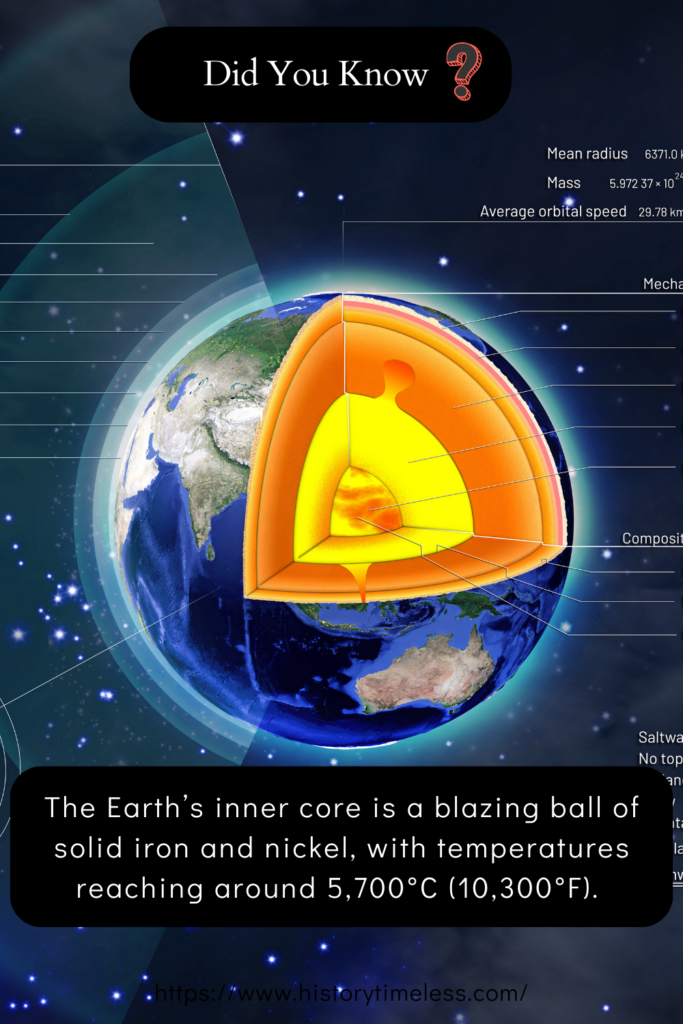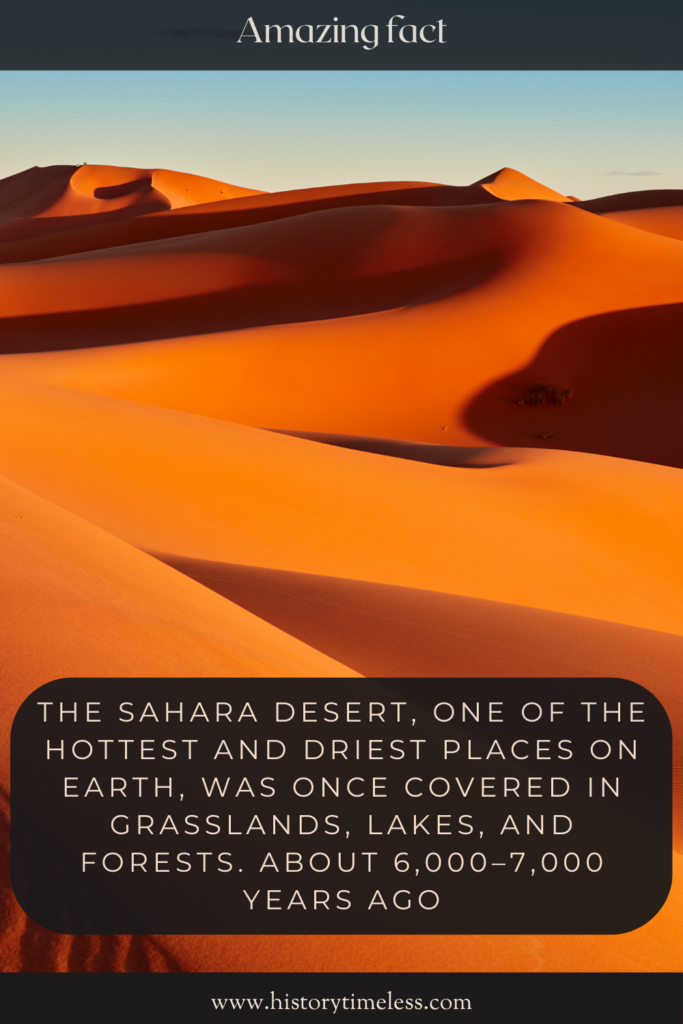Earth is a truly remarkable planet, full of surprises and mysteries that continue to amaze scientists and explorers alike.
From its deep oceans to towering mountains, and from its life-supporting atmosphere to its ever-changing landscapes, our home planet is nothing short of extraordinary.
Whether you’re a space enthusiast, a nature lover, or just curious about the world we live in, these 28 fascinating facts will give you a fresh perspective on Earth’s uniqueness.
1. Earth’s Core Is as Hot as the Sun’s Surface
The Earth’s inner core is a blazing ball of solid iron and nickel, with temperatures reaching around 5,700°C (10,300°F). That’s roughly the same temperature as the surface of the Sun!

Despite these extreme temperatures, the core remains solid due to the immense pressure at the planet’s center.
This scorching heart of our planet plays a crucial role in generating Earth’s magnetic field, which protects us from harmful solar radiation.
2. Earth’s Atmosphere Extends Far Beyond What We See
Most people think Earth’s atmosphere stops where the blue sky fades into space, but in reality, it stretches much farther.
The outermost layer, called the exosphere, extends up to 10,000 kilometers (6,200 miles) from the surface!
This means that technically, the International Space Station orbits within Earth’s atmospheric boundary. However, the air at this altitude is so thin that it practically merges with space.
3. There’s a Giant Ocean Beneath Earth’s Surface
It might sound like something from a science fiction movie, but there’s actually more water hidden beneath Earth’s crust than in all the world’s oceans combined.
Scientists have discovered vast amounts of water trapped in rock formations about 700 kilometers (430 miles) below the surface.
This underground reservoir may help explain how our oceans formed billions of years ago and could play a role in Earth’s water cycle today.
4. Earth Used to Be Completely Covered in Ice
About 700 million years ago, Earth went through a period known as “Snowball Earth,” where the entire planet was covered in ice from pole to pole.
This extreme ice age lasted for millions of years, and scientists believe it may have played a key role in the evolution of complex life.
Eventually, volcanic activity released enough greenhouse gases to warm the planet and melt the ice, allowing life to flourish.
5. The Amazon Rainforest Creates Its Own Rain
The Amazon rainforest is often called the “lungs of the planet” because it produces about 20% of the world’s oxygen. But did you know that it also makes its own rain?
The trees release moisture into the air through a process called transpiration, which helps form clouds. These clouds then release rain, continuing the cycle and sustaining the vast rainforest ecosystem. Without this self-sustaining process, the Amazon might not be the lush, green paradise it is today.
6. A Day on Earth Is Getting Longer
Millions of years ago, a day on Earth lasted only about 18 hours! This is because the Moon’s gravitational pull is gradually slowing down Earth’s rotation. As a result, our days are getting longer by about 1.7 milliseconds per century. While this change is barely noticeable over a human lifetime, in the distant future, Earth’s days will be significantly longer than 24 hours.
7. Earth Has “Moonquakes” Just Like Earthquakes
While we usually associate earthquakes with our own planet, the Moon also experiences seismic activity known as “moonquakes.”
These quakes, detected by instruments left behind by Apollo astronauts, are caused by tidal forces from Earth’s gravity and temperature changes on the Moon’s surface.
Unlike earthquakes, which can last for seconds to minutes, moonquakes can last for hours due to the Moon’s rigid structure.
8. Earth Is the Densest Planet in the Solar System
Despite being smaller than Jupiter and Saturn, Earth is the densest planet in the solar system. This is because our planet has a solid, metal-rich core and a rocky mantle, whereas gas giants are mostly made of lighter elements like hydrogen and helium.
Earth’s density is about 5.5 grams per cubic centimeter, making it the most compact planet relative to its size.
9. More Than 80% of Earth’s Ocean Remains Unexplored
We often think of space as the “final frontier,” but in reality, Earth’s deep oceans are one of the least explored places in the universe.
Over 80% of the ocean floor remains unmapped, and scientists believe there are thousands of undiscovered marine species lurking in the deep.
With advancements in underwater technology, researchers are slowly uncovering the mysteries of the deep sea, revealing strange creatures and alien-like ecosystems.
10. Earth Is Not a Perfect Sphere
Despite what we see in pictures, Earth isn’t a perfect sphere. Due to its rotation, the planet bulges slightly at the equator and is flattened at the poles, making it an oblate spheroid. This shape is caused by centrifugal force pushing outward as Earth spins.
The difference is small—only about 21 kilometers (13 miles) between the polar and equatorial diameters—but it’s enough to make our planet slightly pear-shaped rather than perfectly round.
11. Earth’s Magnetic Field Is Constantly Moving
Earth’s magnetic field is not fixed—it shifts over time due to movements in the molten outer core. The magnetic north pole, for example, has been drifting rapidly in recent decades, moving from Canada toward Russia at speeds of up to 40 kilometers (25 miles) per year.
Scientists believe these shifts could eventually lead to a full reversal, where magnetic north and south swap places, a phenomenon that has occurred many times in Earth’s history.
12. Earth Once Had Two Moons
Some scientists believe Earth may have once had a second, smaller moon. According to this theory, this tiny moon eventually collided with our current Moon, creating the Moon’s rugged far side.
This idea, known as the “double-moon hypothesis,” helps explain why the near and far sides of the Moon look so different, with one being relatively smooth and the other covered in highlands and craters.
13. The Deepest Point on Earth Could Fit Mount Everest
The Mariana Trench in the Pacific Ocean is the deepest place on Earth, plunging nearly 11 kilometers (7 miles) into the ocean floor. If you placed Mount Everest inside it, the peak would still be more than 2 kilometers (1.2 miles) underwater!
This extreme environment, known as the Challenger Deep, is home to some of the most mysterious creatures on the planet, including bizarre, bioluminescent fish.
14. The Sahara Desert Used to Be a Lush Jungle
It’s hard to imagine, but the Sahara Desert, one of the hottest and driest places on Earth, was once covered in grasslands, lakes, and forests. About 6,000–7,000 years ago, the region received much more rainfall, supporting an abundance of wildlife and even early human settlements.

Scientists believe changes in Earth’s orbit and shifts in monsoon patterns eventually caused the desert to expand, creating the vast sand dunes we see today.
15. Lightning Strikes Earth 8 Million Times a Day
Lightning is one of the most powerful natural forces on Earth, and it strikes the planet an estimated 8 million times each day—around 100 strikes per second! The most lightning-prone place on Earth is Lake
Maracaibo in Venezuela, where intense storms create nearly constant flashes of lightning, sometimes for 10 hours a night. These electrical storms are caused by unique atmospheric conditions that trap heat and moisture.
16. Earth’s Gravity Is Not the Same Everywhere
Although we think of gravity as a constant force, it actually varies across the planet. Some areas, like the Hudson Bay region in Canada, have lower gravitational pull than others due to variations in Earth’s mass distribution.
These differences are caused by factors like ice loss, geological activity, and the uneven shape of the Earth. Scientists use gravity maps to study these variations and learn more about the planet’s internal structure.
17. A Single Tree Can Produce Thousands of Liters of Oxygen
Trees play a crucial role in producing the oxygen we breathe. A single mature tree can produce enough oxygen in a year to support two people!
The Amazon Rainforest alone generates 20% of the world’s oxygen supply. Beyond oxygen production, trees also absorb carbon dioxide, filter pollutants, and help regulate the climate, making them vital to Earth’s health.
18. Earth Experiences “Airglow” in the Night Sky
Even in complete darkness, Earth’s atmosphere emits a faint glow known as “airglow.” This phenomenon occurs when solar radiation excites atoms and molecules in the upper atmosphere, causing them to release light.
Unlike the Northern Lights, which are more localized, airglow can be seen worldwide and appears as a soft green or reddish glow when viewed from space. It’s one of the many fascinating ways Earth’s atmosphere interacts with the Sun’s energy.
19. More Than Half of Earth’s Species Are Still Undiscovered
Despite centuries of exploration, scientists estimate that over 80% of Earth’s species have yet to be discovered.
This is especially true for deep-sea creatures, tiny microorganisms, and rainforest-dwelling insects. Every year, researchers identify thousands of new species, from bizarre deep-sea fish to previously unknown plants.
With so much still to be explored, our planet remains a treasure trove of biodiversity waiting to be uncovered.
20. Earth’s Rotation Is Wobbling Over Time
Earth doesn’t spin in a perfectly smooth way—it wobbles slightly as it rotates. This phenomenon, called polar motion, is caused by shifts in mass, such as melting glaciers, ocean currents, and changes in Earth’s mantle.
Over time, this wobbling can slightly affect climate patterns and even the length of a day. Scientists closely monitor this movement to understand how Earth’s internal and external forces interact.
21. Earth’s Oceans Are Slowly Becoming More Acidic
Due to increased carbon dioxide emissions, Earth’s oceans are absorbing more CO₂, causing a gradual decrease in pH levels—a process known as ocean acidification.
This change affects marine life, especially coral reefs and shell-forming creatures, which struggle to build their protective structures in more acidic waters.
Scientists are closely monitoring these changes, as they can have ripple effects throughout the entire ocean ecosystem.
22. The Coldest Temperature on Earth Can Freeze Skin Instantly
The coldest temperature ever recorded on Earth was a bone-chilling -128.6°F (-89.2°C) at Antarctica’s Vostok Station in 1983. At this temperature, exposed skin can freeze in less than a minute!
Even more extreme conditions have been detected in Antarctica’s interior, where satellite data suggests temperatures can drop below -144°F (-98°C) during winter nights. These frigid environments are among the most inhospitable places on the planet.
23. Earth Has a “Heartbeat” of Geological Activity
Every 27 million years or so, Earth experiences a cycle of increased geological activity, including more volcanic eruptions, earthquakes, and tectonic movements.
Scientists aren’t sure why this happens, but some theories suggest it could be linked to deep-Earth processes or even cosmic factors like the solar system’s movement through the galaxy. This periodic “heartbeat” of Earth’s geology is still one of the great mysteries of our planet.
24. There Are Hidden Mountains Taller Than Everest Under the Ocean
Most people think Mount Everest is the tallest mountain on Earth, but in reality, an underwater peak called Mauna Kea in Hawaii is even taller when measured from base to summit.
Rising over 10,200 meters (33,500 feet) from its base on the ocean floor, Mauna Kea dwarfs Everest’s 8,849-meter (29,032-foot) height. However, because much of it is submerged, Everest still holds the title for the highest point above sea level.
25. The Largest Living Structure on Earth Is Visible from Space
The Great Barrier Reef, located off the coast of Australia, is the largest living structure on Earth. Spanning over 2,300 kilometers (1,400 miles), this vast coral ecosystem can even be seen from space!
It’s home to an astonishing variety of marine life, including over 1,500 species of fish, sea turtles, sharks, and vibrant corals.
Sadly, rising ocean temperatures and pollution threaten its survival, making conservation efforts more crucial than ever.
26. Earth Has “Zombie Fires” That Burn Underground for Years
In some parts of the world, particularly in Arctic regions, wildfires can continue smoldering underground for months or even years.
These so-called “zombie fires” survive beneath layers of peat and soil, reigniting when conditions become dry and warm.
Scientists are concerned that climate change is increasing the frequency of these fires, which release vast amounts of carbon into the atmosphere and contribute to global warming.
27. Earth’s Water Is Older Than the Sun
The water we drink today is billions of years old—older than the Sun itself! Scientists believe that much of Earth’s water came from ancient ice-rich comets and interstellar dust particles that existed before the solar system formed.
This means that the molecules in your glass of water have been traveling through space for billions of years, making their way from distant cosmic origins to our planet’s oceans, rivers, and lakes.
28. A Mysterious “Hum” Vibrates Through Earth
Even when there are no earthquakes, Earth emits a faint but constant seismic hum. This low-frequency vibration, known as Earth’s background free oscillation, was first discovered in the 1990s.
Scientists aren’t entirely sure what causes it, but theories suggest it may be due to ocean waves, atmospheric pressure, or even deep-Earth activity. This eerie, ever-present hum is another reminder that our planet is always in motion, even when we don’t feel it.
Learn some astonishing new knowledge:
26 Amazing Facts About Digital Marketing!
25 Stunning Sagittarius Facts For Woman!
20+ Insane Facts About Animals That Defy Belief!
15+ Interesting World Facts: Say ‘Wow’ to These Discoveries!





